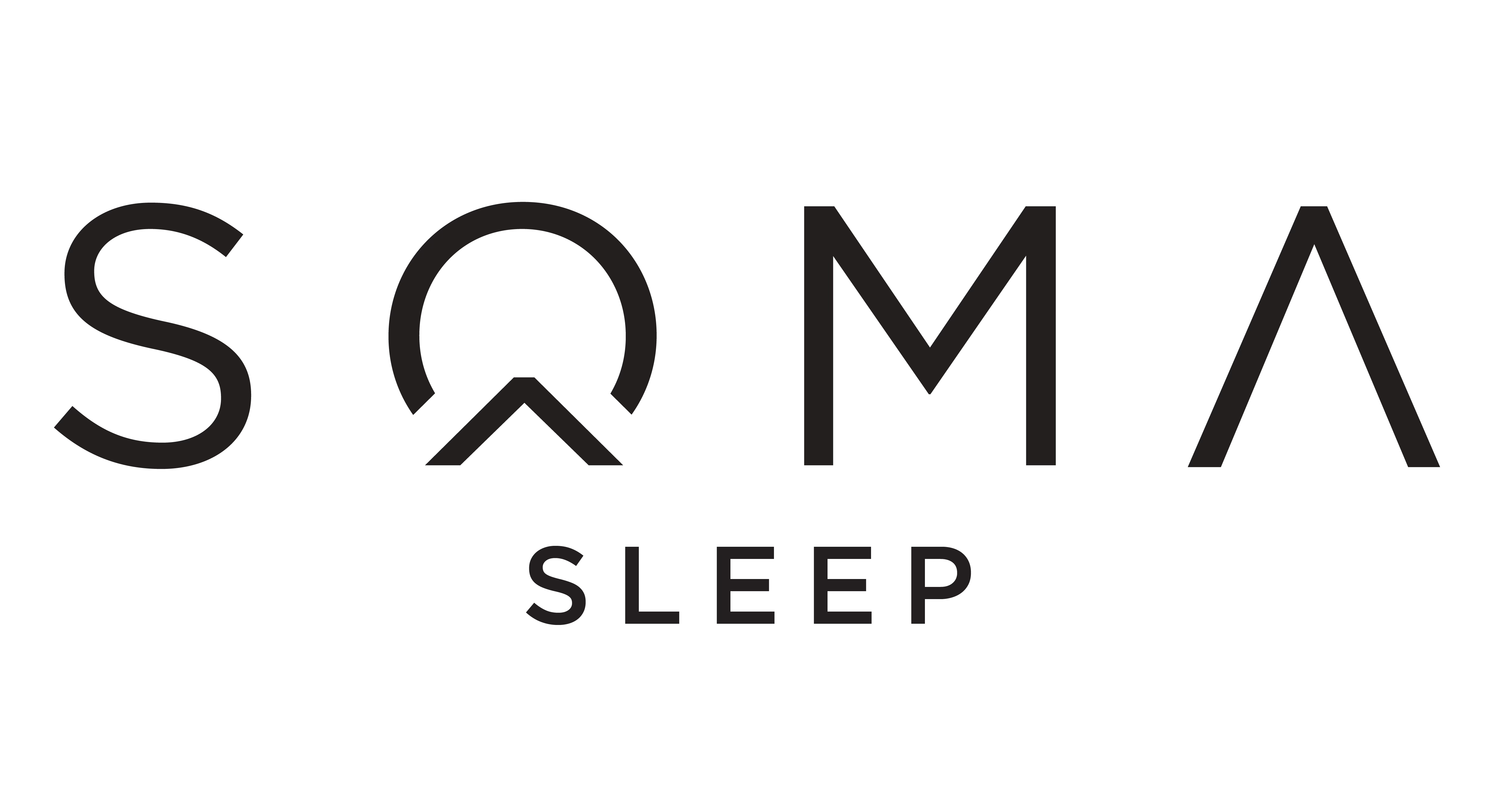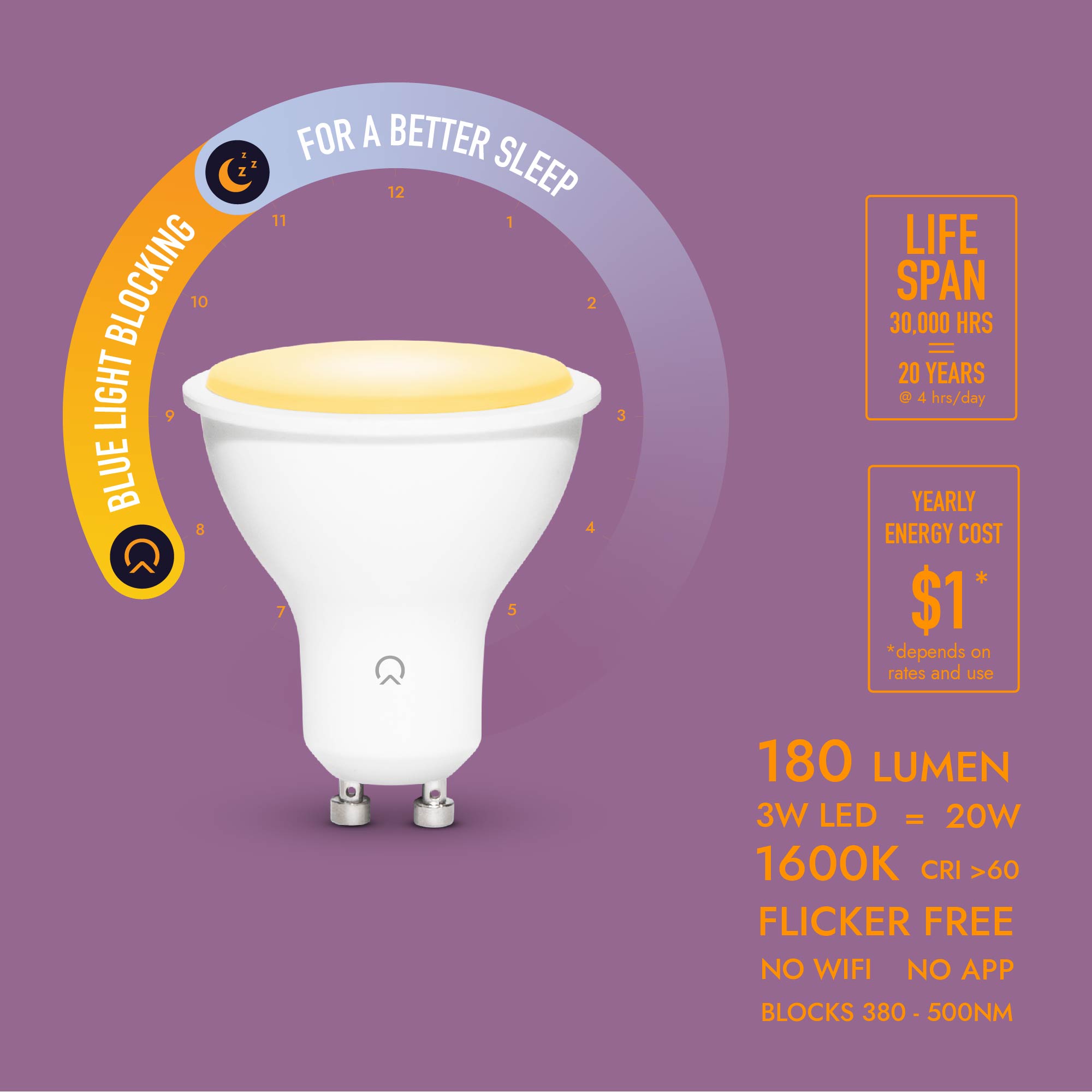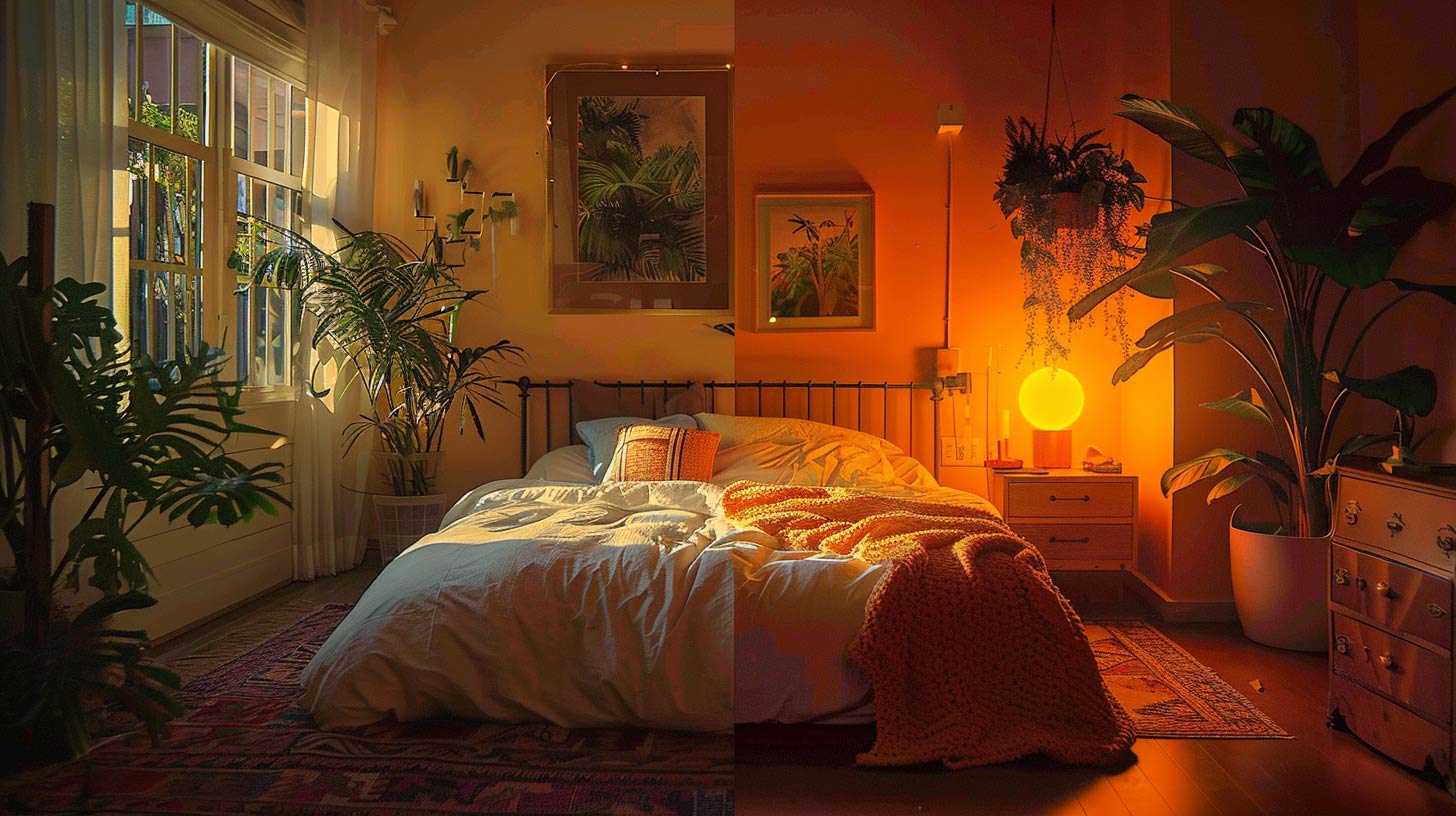Unlock Better Sleep Through Light
Sleep isn’t just rest, it’s your body’s reset button. Light is the most powerful signal your brain uses to tell you when to sleep, wake, and perform at your best. On this page, you’ll explore the science behind circadian biology, melatonin, and light, and discover research-backed strategies to protect your body clock, so you can fall asleep easier, sleep deeper, and wake up ready to thrive.
Section 1
The Problem with Modern Light
For most of human history, night-time meant fire, moonlight, and stars, all warm, dim, and naturally low in blue wavelengths. This light environment supported melatonin production and deep, restorative sleep.
Today, the story is very different. Homes are filled with overhead LEDs, screens, and bright downlights. These sources are 100–1000 times brighter than natural dusk and heavy in blue light, sending a powerful, but misleading message to your brain: “It’s still daytime.”
Consequences of evening light exposure:
- Delayed or suppressed melatonin release
- Later bedtimes and reduced sleep quality
- Chronic circadian disruption linked to mood disorders, metabolic disease, and impaired immune function
“Modern lighting is one of the most significant environmental mismatches humans face today.”— Dr Alexander Wunsch, Photobiology Researcher
Reference
Section 2
The Circadian Rhythm - Your Body’s Master Clock
Your body runs on a near-24-hour cycle known as the circadian rhythm. It regulates sleep, hormones, digestion, body temperature, and even gene expression.
At the centre is the suprachiasmatic nucleus (SCN), a tiny cluster of ~20,000 neurons in the hypothalamus. The SCN acts as the master clock, sending timing signals to every cell and organ.
When aligned, this system produces stable energy, good sleep, and resilient health. When misaligned through late nights, irregular schedules, or artificial light the body’s clocks fall out of sync, impairing sleep, mood, metabolism, and long-term health.
“Every organ and cell in the body has its own circadian rhythm. Light is the master synchroniser.” - Dr Satchin Panda, Salk Institute
Section 3
Light - The Master Timekeeper
Light isn’t just for vision, it's the strongest signal your brain uses to keep time.
Specialised retinal cells called ipRGCs (intrinsically photosensitive retinal ganglion cells) detect light, particularly in the blue range (460–480nm). They send signals directly to the SCN, which adjusts your entire circadian rhythm.
- Morning light triggers cortisol and dopamine, raising body temperature and boosting alertness.
- Daylight stabilises mood and energy.
- Evening blue light suppresses melatonin, delaying your sleep clock.
Cutting-edge research shows it’s not just ipRGCs at work. Other opsins (light-sensitive proteins) like OPN5 (neuropsin)may also influence circadian timing and metabolism. Some studies even suggest that infrared and near-infrared light could protect melatonin indirectly by supporting mitochondrial function.
“Blue light has a strong alerting effect and suppresses melatonin more than any other wavelength.” - Dr George Brainard, Thomas Jefferson University
“Light is the most powerful synchroniser of the circadian system.” - Dr Till Roenneberg, LMU Munich
Reference
Brainard et al. (2001). Action Spectrum for Melatonin Regulation.
Section 4
Melatonin — Your Internal Night Signal
Melatonin isn’t a sedative. It’s your biological night signal, a hormone released by the pineal gland when darkness falls. Rising levels tell your body it’s time to rest, repair, and prepare for sleep.
Under natural conditions, melatonin rises after dusk, peaks at night, and falls again before dawn. But exposure to artificial light, especially blue-rich LEDs or screens can suppress melatonin by 50–80%, delaying sleep and reducing recovery.
"Melatonin is not a sedative, but a signal that the biological night has begun.” - Dr Russell Foster, University of Oxford
“Exposure to room light before bedtime suppresses melatonin onset and shortens melatonin duration in humans.” - Gooley et al., Journal of Clinical Endocrinology & Metabolism
Reference
Gooley JJ et al. (2011). Exposure to room light before bedtime suppresses melatonin onset.
Section 5
Frontier Science — Beyond the Basics
Circadian research is advancing rapidly, revealing layers of complexity beyond the standard “blue light blocks melatonin” story.
1. Non-Visual Opsins
Proteins like OPN5 (neuropsin) and OPN3 (encephalopsin) may tune circadian and metabolic rhythms independent of classic pathways.
2. Mitochondrial Connection
Emerging work suggests that infrared light may help maintain melatonin by supporting mitochondrial energy production — linking circadian health to cellular metabolism.
3. Genetic Chronotypes
Variants in PER and CRY genes help explain why some people are natural “larks” and others “owls.” Misaligning lifestyle with genetic chronotype may increase health risks.
4. Circadian Disruption as a Health Risk
The World Health Organization now classifies night shift work as a “probable carcinogen,” reflecting its links to cancer, obesity, and diabetes.
Expert Insights
“The circadian system regulates virtually every aspect of our physiology. Its disruption has profound health consequences.” - Nobel Laureates Jeffrey Hall, Michael Rosbash, and Michael Young
Section 6
Practical Actions to Support Your Clock
Science is powerful, but it’s only useful if you can apply it. Here are the most effective, evidence-based ways to protect and align your circadian rhythm:
Get morning sunlight within 30 minutes of waking
Spend time outdoors during the day for light anchoring
Dim lights after sunset; replace overhead LEDs with amber light (like Soma Sleep bulbs)
Avoid screens at night or use blue-light filters
Keep consistent sleep and wake times
Finish eating 2–3 hours before bed; avoid caffeine after 2pm
Wind down with a ritual: stretching, meditation, or yoga nidra
Optimise your sleep environment: cool (18–20°C), dark, quiet
more
Key Scientific Studies on Blue Light
A growing body of research highlights the impact of blue light on both eye health and sleep. The following studies provide the experimental and clinical evidence behind these findings.
Blocking nocturnal blue light for insomnia: A randomized controlled trial (2018)
“The use of light-emitting electronic devices before bedtime may contribute to or exacerbate sleep problems. Exposure to blue-wavelength light in particular from these devices may affect sleep by suppressing melatonin and causing neurophysiologic arousal.”
Retinal damage induced by commercial light emitting diodes (LEDs) (2015)
"The blue component of LED is the major cause of retinal damage"
The Effects of Pre-bedtime Blue-Light Exposure on Subjective Sleep Quality, Attention, and Work Efficiency in Men Students: A Pilot Study.
The present study suggests that blue-light exposure before bedtime leads to a decrease in the ratio of deep sleep and negative effects on sustained attention and work efficiency.
Impacts of Blue Light Exposure From Electronic Devices on Circadian Rhythm and Sleep Disruption in Adolescent and Young Adult Students
Research in Chronobiology in Medicine (2023) discusses how blue light emitted from electronic devices, especially during the evening, can disrupt circadian rhythms and suppress melatonin production, leading to sleep disturbances.
Removal of the blue component of light significantly decreases retinal damage after high intensity exposure (2018)
Light causes damage to the retina (phototoxicity) and decreases photoreceptor responses to light. The most harmful component of visible light is the blue wavelength (400–500 nm).
Protective effect of blue-light shield eyewear for adults against light pollution from self-luminous devices used at night (2015)
Sleep efficacy and sleep latency were significantly superior for wearers of the blue-light shield (P < 0.05 for both), and this group reported greater sleepiness during portable device use compared to those using the control eyewear. Participants rated the blue-light shield as providing acceptable visual quality. Study abstract here.
Amber lenses to block blue light and improve sleep: a randomized trial (2009)
All light is not equal: blue wavelengths are the most potent portion of the visible electromagnetic spectrum for circadian regulation. Therefore, blocking blue light could create a form of physiologic darkness. At the end of the study, the amber lens group experienced significant (p < .001) improvement in sleep quality relative to the control group and positive affect (p = .005). Mood also improved significantly relative to controls. View abstract here.
Blue blocker glasses impede the capacity of bright light to suppress melatonin production (2006)
"Blue blockers represent an elegant means to prevent the light-induced melatonin suppression."
“Our data show that, irrespective of gender, orange lens glasses can effectively block the capacity, of a 1-hr light pulse of 1300 lx in the eye, to suppress melatonin production.”
Scientific Evidence Suggesting
Artificial Blue Light Can Cause Eye Damage
While healthy exposure to natural blue light during the day offers many benefits, artificial sources of blue light from screens, devices, and LED and fluorescent lighting expose us to unnaturally high levels. Studies clearly show that this excessive exposure can lead to permanent eye damage. Symptoms include sore and dry eyes, eye strain, headaches, and migraines, and can even result in conditions such as macular degeneration.
Retinal damage induced by commercial light emitting diodes (LEDs) (2015)
"The blue component of LED is the major cause of retinal damage"
"LED light caused a state of suffering of the retina with oxidative damage and retinal injury. We observed a loss of photoreceptors and the activation of caspase-independent apoptosis, necroptosis, and necrosis"
Removal of the blue component of light significantly decreases retinal damage after high intensity exposure (2018)
Light causes damage to the retina (phototoxicity) and decreases photoreceptor responses to light. The most harmful component of visible light is the blue wavelength (400–500 nm). Read the entire study here.
Research progress about the effect and prevention of blue light on eyes (2018)
In recent years, people have become increasingly attentive to light pollution influences on their eyes. In the visible spectrum, short-wave blue light with wavelength between 415 nm and 455 nm is closely related to eye light damage. Read more about this research here.
Bystander effects elicited by single-cell photo-oxidative blue-light stimulation in retinal pigment epithelium cell networks (2017)
"blue LED light has been shown to induce more damage than white or green light, and induce ROS production and lipid peroxidation in RPE cells, resulting in apoptotic cell death. Finally, intense blue light can cause mitochondrial and nuclear DNA damage." Full study here.



